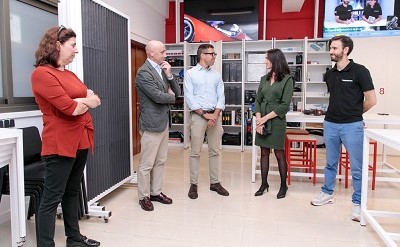- University students from any discipline can use this space to develop their innovative projects
- The room and its features are highly versatile, offering multiple use possibilities
Everything in this space is created by the students, from the tables and chairs to the cabinets and the design of the room itself, as well as its contents. A large group of students led this initiative and spent months working on getting everything ready for it, even during vacation periods.
It so happens that they all belong to the TEIDESAT project, where they are creating a nanosatellite that they intend to put into orbit within two years, which is being designed by undergraduate, master's, and doctoral students. This highly motivated group thus devised, on behalf of the Fundación Cepsa Chair of Ecological Transition and Innovation, everything the MakerSpace needs to become a multidisciplinary creation space.
The space can be converted into a meeting room, a classroom, a workshop, an exhibition space, a place for electronics and radio tasks, a MOOC classroom to record large online courses, and even a small control room for the students of the University of La Laguna’s space missions, like the one they are working on.
It has a wide range of electrical and electronic tools and materials, a large format printer and 3D scanner, a laser cutter, and augmented reality equipment, among many tools. It also has the equipment needed to air live radio broadcasts and group videoconferences and is equipped with a high-powered computer that will be used, among many other uses, for advanced simulations.
The room was inaugurated by Cepsa’s head of Corporate Relations in Andalusia and the Canary Islands, Jesús Velasco; the head of Fundación Cepsa in the islands, Belén Machado; the vice-rector of Digital Agenda and Modernization at ULL, Jorge Riera; and the academic director of the Chair, Elena Pastor.
Master's student Joshua Barrios was in charge of leading the visit and presenting the details of the space, while also introducing the members of the work team that made this space possible. The student explained that they will soon have a preliminary version of the nanosatellite, and that this new space will help them carry out their work more quickly. He also reported that they have a high-performance computer for numerical simulations. The team also plans to install two antennas to 'talk' to the satellite when it is in orbit near the university school.
The room has space for other ULL student teams, such as Moto Student (which the Chair also collaborates with) and Formula Student, creators of two electric vehicles for university competitions, for them to leave their materials and develop their own projects. The students have even devised an access control that manages different permissions. The relationship between Computer Engineering students and Electronics and Mechanics students has allowed many developments to be carried out, they explained.
Belén Machado thanked the commissioned student work team for their involvement and dedication, not only in executing the project, but also in determining what the room should include after surveying a multidisciplinary group of students, so that "this space will be useful for numerous groups and students at the University of La Laguna, in almost any discipline, thus fulfilling the main objective we had when we devised this initiative." In addition, "for some of them it was their first work experience, and they threw themselves into it, demonstrating that they are not only very well prepared, but also highly motivated and full of creative potential," she said.

